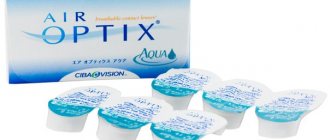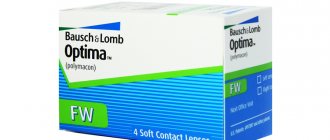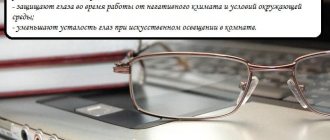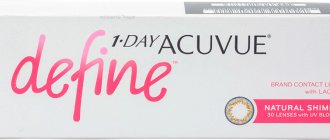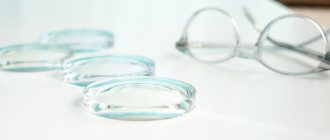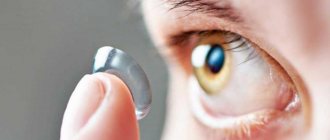Everyone who uses contact lenses at some point faces the question of which ones to choose: with what replacement period, wearing regimen, quality indicators. For beginners, doctors often recommend same-day replacement lenses. Why this is so and how they differ from multi-day ones will be discussed in this article.
When choosing contact optics, many questions may arise: “Which lenses?”, “What is the difference between one-day lenses and two-week ones?” An ophthalmologist or optometrist can answer all such questions.
Let's look at the similarities and differences between one-day models and those designed for two weeks.
Lenses for one day
The MagazinLinz catalog contains several dozen options for one-day contact models, here are the most popular and selected:
- 1-Day Acuvue TruEye;
- Dailies AquaComfort Plus;
- 1-Day Acuvue Define “Natural Shine”;
- Daily Total1;
- ACUVUE OASYS 1-Day with HydraLuxe.
If you are a beginner, and behind these beautiful names you would like to see the parameters of the products and decide which specific product is right for you, you need to consider their properties, and also understand how one-day lenses differ from two-week ones.
Unique color devices
Most often, colored lenses are used to change the image, but this effect can also be combined with vision correction.
Colored lenses are expensive, but the more expensive they are, the better the quality of the material from which they are made and the lower the risk of complications from wearing them.
Colored lenses are made only from hydrogel. And it has low permeability to oxygen, so it is undesirable to use them often and for a long time, this can lead to hypoxia of the eye tissue. In addition, ophthalmologists do not recommend wearing such lenses after sunset.
At night, the pupil dilates and the colored part of the lens enters the visibility zone, which interferes with normal vision. Also, doctors categorically prohibit the use of lenses when driving a car or working in production.
Tinted lenses come in tint and color:
- Tinted lenses are lenses that can only slightly change the shade of your eyes.
- Colored contact lenses are used to completely change the color of the iris.
Tinted lenses do not give your eyes an unnatural look; on the contrary, they make them more expressive. Such products have the property of protecting the eyes from ultraviolet radiation.
Contact lenses come in many colors, but the most attractive are:
- black. Mainly used to create a specific image (for example, for Halloween);
- blue;
- green;
- scleral
Colored lenses will give your eyes an unusual deep shade, make your eyes brighter, and emphasize your look. But do not forget that before buying colored lenses, you should definitely consult with your ophthalmologist.
He will tell you in more detail about the advantages and disadvantages of such lenses, after which you can choose the ones that are right for you.
.
Among the companies that produce colored lenses, we need to highlight the best.
These include:
- Ciba Vision;
- Neo Vision;
- Interojo;
- Cooper Vision.
Pros of daily use optical lenses
The first thing you need to understand about daily lenses is that their use is as hygienic as possible, which cannot be said about multi-day lenses. By purchasing a package of optical contact correction products for every day, you save yourself from the possibility of becoming infected with harmful bacteria. You don’t have to touch your eyes again: in the morning you open the sealed package of new contact lenses and put them on, and in the evening, before going to bed, you take them off and throw them away, since they are not intended for long-term wear (which is why they are called daily). There is no need to remove and put on the same daily contact lenses in the morning; the next day you repeat the procedure again. Thus, a package marked 30 pieces will last you 15 days if you have the same diopters in both eyes.
The second advantage of one-day products is that you do not need to buy or order related care products, without which the use of multi-day products is unthinkable. For example, long-term wear products require a multi-use solution, a container, tweezers, a travel kit, and may also require moisturizing drops.
Are night lenses safe?
The relatively high price of overnight contact lenses makes many patients question whether the method is just another marketing gimmick. Until recently, doctors themselves doubted the effectiveness and, most importantly, safety of orthokeratological lenses. The production technology was not debugged, the materials taken were controversial. But today the situation has changed.
Modern night lenses receive good reviews from experts and are even recommended for children, due to the following factors:
- significant change in production technology. Unlike the first samples, modern night lenses are made on reliable equipment with high precision;
- use of proven materials. This method of vision correction has often been criticized due to the fact that the eyes “do not breathe” at night while under the lenses. But today's popular gas-permeable materials are the answer to this claim. They are safe for the eyes and do not harm the retina or cornea;
- improved form of night lenses. The new format allows you to more accurately align the shape of the cornea without harming the eyes;
- the emergence of detailed studies on the effectiveness of using orthokeratology lenses. Safety and guarantee of results are confirmed not just by theoretical calculations, but also by practical research. They report that the course of treatment results in a significant inhibition of the development of myopia.
In the context of the early development of many eye diseases, modern methods such as night vision correction can become one of the leading ways to reduce myopia and inhibit its development. Therefore, you should not refuse this treatment. At the moment it is absolutely safe!
What to choose?
Of the above-mentioned models, daily lenses Dailies AquaComfort Plus are in high demand among users. These daily replacement products have increased moisture content and also have an aspherical shape, which helps to see the image without any distortion. The hydration system of the presented contact correction products allows you to safely wear them throughout the day with increased comfort.
Also on the pages of the MagazinLinz.ru website you can order 1-Day Acuvue TruEye daily lenses from Johnson & Johnson, which have less moisture but are “breathable”. The gas permeability index of Acuvue lenses is 118, which is significantly higher than that of other contact lenses in this segment.
If your funds allow you to choose daily contact lenses in a larger price category, and the maximum in both indicators of the quality of optical products is fundamentally important to you, then the Dailies Total1 product from Alcon is suitable, combining 80 percent moisture in each lens, and at the same time oxygen permeability index, which is difficult to compete with - 156 units. Daily Total 1 is designed for those with sensitive eyes.
Monthly lenses
Monthly lenses have a denser structure; regardless of this, they transmit oxygen well to the mucous membrane of the eyes. They are well suited for people just starting to get used to CL, as they are harder to damage than one-day models.
They are made from a silicone hydrogel base, so tear fluid is retained under the surface of the lenses.
This prevents the mucous membrane from drying out during prolonged use. There are daily pairs or prolonged wear. The latter option can be worn at night. This is suitable for people who often travel, business trips or work at night.
Advantages
Monthly contact optics have a number of advantages that may appeal to a certain category of people.
Pros:
- Lower cost compared to one-day models. One pair is designed for one month of daily wear, but continuous use can be extended for no more than 1 week.
- Increased visual acuity even with high levels of myopia or farsightedness. Due to the large layering of the structure, the lenses are worn with the greatest deviations in visual acuity.
- With these models you can see at dusk. This is an advantage for people who drive vehicles.
- The lenses are suitable for people who work in conditions that damage the mucous membrane of the eyes. Such places of work include prolonged sitting at a computer and being in an air-conditioned space. When using chemicals that damage the unprotected lining of the eyes, wearing lenses can protect against damage.
- Production of lenses from hydrogel or silicone hydrogel. The second option protects your eyes from ultraviolet radiation. This is an advantage, but the cost of such pairs increases. They are suitable for people whose eyes become irritated and watery when exposed to bright light.
Flaws
There are disadvantages to one-month contact lenses that may cause a person to choose a different type of optics. Ask your ophthalmologist about them before use.
Flaws:
- Prolonged wear increases the risk of developing a bacterial infection. Pathogenic microorganisms may accumulate on the walls of the container in which the vapor is placed for overnight storage. This is fraught with inflammation of the conjunctiva, cornea, and eyelids.
- A harder base can cause damage to the mucous membrane of the eyes, irritation, and redness. These effects often occur in people who are just starting to wear contact lenses. In this case, they are replaced with models with a shorter shelf life, since they have a softer structure.
- Additional purchase of a container and solution for storing lenses. A certain group of patients may experience allergic reactions to the latter substance.
- Buying drops to moisturize your eyes. If a person wears the model for an extended period of time, it causes dryness due to a decrease in the amount of tear fluid between the cornea and the lens. Good products are expensive and run out quickly.
We recommend reading: How to properly put on and remove lenses
Two-week lenses
The MagazinLinz online store boasts an assortment of contact optics of any wearing mode, replacement period, brand and type. Before you understand the difference between one-day lenses and multi-day lenses, you need to study the market for two-week products.
Our website presents brands such as:
- Acuvue Oasis;
- Aquamax;
- Prima;
- Sofclear;
- Fusion Nuance.
One of the most comfortable lenses to wear with a replacement period of two weeks are Acuvue Oasys from ]Johnson&Johnson[/anchor]. The quality of these multi-day lenses is determined by the increased level of oxygen permeability; Acuview Oasis is one of the best “breathable” products. In addition, Acuvue Oasys can be used in a prolonged and even continuous mode, that is, the lenses can be worn for up to 6 days without removing them at all. You need to give your eyes a rest once a week.
Biocompatible lenses
Usually, when putting on such a product, the body begins a kind of struggle, because it perceives it as a foreign body. Therefore, a protein is produced that is deposited in the eye. This makes the lens an element of the eye. Unique materials have maximum similarity to the natural composition of eye tissues.
The components have such advantages as resistance to the production of deposits and dehydration. They also minimize the likelihood of allergic reactions and drying of the eye.
5 / 5 ( 7 votes)
What is the difference between one-day lenses and two-week ones?
Every person suffering from refractive errors, including astigmatism, can choose suitable means of contact vision correction on our website. And when choosing them, a beginner, as well as an experienced user who decides to change the usual, for example, quarterly lenses to other, less long-term ones, has a lot of questions.
- How are some lenses different from others?
- Which is better: one-day or two-week?
- Which manufacturer should you prefer?
- If you choose daily lenses, which ones?
The main difference between one-day and two-week lenses is that they are more sterile. Every morning you put on a new pair, which means that pathogenic bacteria simply do not have time to accumulate on them. For sensitive eyes that react to even the most insignificant factor with redness and inflammation, daily lenses are practically the only way out of the situation. While two-week contact correction products, although they cannot be called long-wear lenses, are still a more favorable environment for microbes to live, which means the risk of conjunctivitis, various blepharitis and other inflammations is greater than in the case of one-day lenses.
How else do one-day lenses differ from two-week ones: the former do not require any accessories for the obvious reasons described above, while for the correct hygienic use of the latter, a unique arsenal of care products is required. Without the cleaning solution and container, the lenses cannot be used.
The next important difference between daily lenses is the price category. Daily lenses are not cheap. For sterility and high quality indicators, you have to pay from 1,500 to 3,000 thousand rubles per month, which for some is not an important criterion, but for some buyers this is the main point. Two-week lenses, like other long-wear lenses, are more affordable.
Another final comparison factor is wearing mode. For day-olds, it is strictly regulated: during the day. While with high-quality biweekly lenses, variations are possible at this point: from wearing exclusively during waking hours to continuous wear, up to one week. Thus, the differences between one-day and two-week lenses are as follows:
- level of sterility during wearing;
- presence or absence of need for care products;
- price category;
- wearing mode.
Changing glasses to a set of night lenses will help your baby
- play sports without restrictions;
- refuse glasses that are easy to break;
- stop being an object of ridicule and forget about being called “bespectacled.”
Parents, in turn, stop worrying that their child will lose glasses or contact lenses due to carelessness or active games.
Adults also often resort to using night lenses. They are usually prescribed to patients aged 18 to 40 years. Theoretically, there are no restrictions for wearing this type of healing elements. But closer to 40 and beyond, a person begins to develop not only myopia, but also other problems.
Thus, treatment with night lenses is contraindicated in case of severe dry eyes, and it is noticed in the vast majority of patients over 40. Night lenses should be worn with caution for those who have presbyopia or farsightedness. Almost everyone develops it as they get older.
It is interesting that the diverse designs available in lenses for night vision correction already make it possible to influence the eyes of people suffering from hypermetropia, presbyopia, and astigmatism. Perhaps new designs that will be even more effective will be developed in the near future.
conclusions
In comparing daily and two-week contact lenses, it is impossible to single out a leader, or to say that daily lenses are better or worse, because each category is created for its own user. Based on factors such as the preferred wearing mode, the budget for contact lenses, as well as an individual schedule, each person with a vision defect - whether with myopia, farsightedness, or astigmatism - decides which type of contact vision correction is best for him . We also remind you that this decision should be made exclusively together with your ophthalmologist. Only a competent specialist will be able to recommend a suitable model based on the diagnosis and individual characteristics.
MagazinLinz.ru team
Suitable lens material
Based on the material from which lenses are made, they are divided into hard and soft. Hard ones are divided into gas-impermeable and, accordingly, gas-permeable, and soft ones, in turn, into hydrogel and silicone hydrogel.
Rigid gas-tight lenses are the ancestors of all types of lenses. Today they are practically not used, since they are not completely harmless to eye health. Due to complete impermeability to oxygen, they cause eye hyperemia, hypoxia of eye tissue and the development of more serious complications.
Gas permeable rigid lenses are also gradually becoming a thing of the past because, despite their higher oxygen permeability than previous lenses, they lag far behind soft contact lenses.
Today, soft contact lenses are most often prescribed.
Hydrogel lenses are the most comfortable to wear due to their thinness and softness. Their main advantage is their high moisture content.
Silicone hydrogel lenses, thanks to the addition of silicone, provide better oxygen supply to the cornea, preventing eye hypoxia. They are softer than hydrogel lenses and hold their shape better. They are recommended to be worn only during the daytime and for no more than two weeks.
Which contact lenses are preferable is up to you to decide. After all, it all depends on the recommendations of your ophthalmologist and what eye diseases you suffer from.
The health of your eyes will depend on how you follow the rules for caring for contact lenses and maintaining eye hygiene! It is also advisable to give your eyes a rest - wear glasses. After all, the health of your eyes is the key to good vision!
Who is best suited for?
There are several factors under which ophthalmologists recommend wearing daily lenses.
- Allergic reactions. Sometimes a person is allergic to the storage solution. In this case, it is better to exclude its use by using ephemeral ones.
- No need for daily wear. If a person needs this means of vision correction infrequently, then it is more profitable to use everyday models. The lenses begin to expire after opening the package, and if the owner needs them 1-2 times a month, then there is no need to buy models for long-term wear.
- Worn by teenagers. Often teenagers forget about changing lenses or the need to care for them, which is fraught with risks to the eyes.
- For travel. In order not to take a jar of solution and a container with you on a trip, it is better to stock up on several blisters.
- When working in dusty or chemical environments.
Also, daily replacement lenses are suitable for those who are just learning to put them on their eyes. In such people, they may fall out when putting them on or taking them off, and as a result, the lenses may be lost. Losing one-day items is not as costly as monthly options.
Contact lenses - a current trend in optics
Modern statistics show that the number of people with low vision is steadily growing. This is due to the constant use of computers, background nervous tension and many other factors.
And this, in turn, leads to the growing relevance and development of optical salons throughout the country.
And if a few years ago a person with poor vision could be easily recognized on the street by the presence of glasses, today, keeping up with the times and not wanting to stand out from the crowd on this basis, people increasingly prefer contact lenses.
Three-month lenses
Such products are undesirable for people under 27 years of age, until the body is fully formed and the possible deterioration of vision has not slowed down.
Doctors do not recommend wearing them in dry rooms and cities with dirty, dry air, because the required moisture content of the lenses is maintained for the first month and a half, and then the likelihood of mechanical damage to the product on the eye itself increases.
Speaking about which lenses are best to choose, it should be noted that, first of all, they must allow air to pass through, retain moisture and at the same time contain the required amount of moisture for as long as possible.
It is difficult to single out individual manufacturers, since all models with such a long service life are absolutely the same type.
Attention! The lenses are not designed for long-term wear* due to the rapid evaporation of moisture.
Types of contact lenses for eyes for long-term or multi-day wear
According to the basic classification, contact lenses for long-term wear are divided into 3 types.
Hydrogel
Made from a material consisting mainly of water. This is due to their high throughput; the corneas of the eyes receive enough oxygen. They are very thin, so they are practically not felt when worn and do not cause any discomfort (however, they tear easily).
The surface “repels” protein deposits, so processing should take a minimum of time. Also, protein deposits often provoke the development of allergies. When using hydrogel contact lenses for extended wear, the risk of such a reaction is significantly reduced.
The main disadvantage is the minimal (no more than a week) period of use. Then the moisture begins to quickly evaporate, a feeling of “sand” appears in the eyes, the cornea dries out, and hypoxia may develop.
Rigid gas permeable
Sometimes considered obsolete. Made from silicone-containing material. It is characterized by:
- good breathability;
- high wear resistance;
- ability to keep its shape for a long time (does not break, does not stretch).
There is no water in the material, so the lenses do not dry out when worn in uncomfortable conditions (in the wind, in a stuffy room). You can leave them on while you sleep; this will not harm your eyeballs. There is no unpleasant sensation in the eyes; even with prolonged wear, you do not have to moisturize the cornea with drops or gels.
The advantage of hard contact lenses is their suitability for use even with diagnoses that are a contraindication for wearing soft models (astigmatism, age-related hypermetropia).
But it is difficult even for an ophthalmologist to choose a model that fits well on the eyes (tightly adjacent to the cornea). Specific sensations when wearing require adaptation to them. Individual intolerance with rigid gas-permeable optics occurs more often than with other varieties.
Silicone hydrogel
Combines the advantages of the 2 previous materials. The surface is polished with a laser, and during processing it receives an electrostatic charge to “repel” proteins. The soft material allows oxygen to pass through well, but water from its surface evaporates slowly. It is wear-resistant and resistant to protein deposits.
The lenses do not distort the image and do not cause any harm to the eyes if you do not remove them during sleep. But if you neglect regular treatment and disinfection, lipid deposits accumulate on the surface. This is due to the presence of silicone in the composition.
As a result, the process of natural moistening of the eyeballs with tears is disrupted, and the lenses begin to rub against the drying cornea, causing discomfort. If proper care is followed, they can be worn without taking them off for 30 days or more.
Why are daily disposable contact lenses intended for one-time use only?
The first daily soft contact lenses were developed by Johnson & Johnson Vision Care in the 90s of the 20th century, that is, relatively recently. The creation of “one-day” clinics was a natural completion of the development of the ideology of planned replacement of contact lenses, which initially, in the late 1980s, caused a lot of controversy and objections from conservative contact doctors. Completion in the sense that further reduction in replacement time does not seem to be an appropriate and sensible action. Naturally, at first the production cost of one such lens was high, which negatively affected the retail price, but over time it was reduced to a more or less acceptable level, and one daily lens began to cost approximately one US dollar. You don’t need to be a rocket scientist to calculate the cost of one patient for an annual set of daily lenses: provided that packs of 30 lenses are purchased and the user wears them on each eye five days a week, it turns out that he will have to “unfasten” a year. no less than 520 dollars, or 43 dollars per month. In principle, it’s hard to call this amount high now - by and large, the costs are not much higher than the monthly payment for a dedicated Internet line.
However, a principle is deeply rooted in the minds of users and ordinary people: if there is no difference, then why pay more? For the majority of people, in appearance, a daily soft contact lens is no different from a monthly replacement lens, and, accordingly, the consumer has a logical question: “Are greedy transnational corporations trying to cheat me once again?”
This question is discussed from time to time on the pages of the yellow press. Thus, in April 2006, in the British consumer magazine Which? a rather scandalous article was published on the topic of daily lenses as a way of fishing money out of the pockets of naive Englishmen. The publication continued the campaign to “expose” manufacturers of soft contact lenses - in particular, this topic was discussed in July 2005 on the pages of the Daily Mail newspaper. The leitmotif of the article in “Which?” The problem is that daily lenses from most manufacturers are supposedly no different from menstrual lenses. In the process of preparing the material, the authors sent requests to manufacturing companies, asking them to provide them with the characteristics of the produced daily lenses. Then some “experts” compared them with the characteristics of scheduled replacement lenses and concluded that of the products of the five companies surveyed, only one has a significant difference from scheduled monthly replacement lenses.
Similar thoughts were contained in a note in the Daily Mail. Its author has enlightened English soft contact lens wearers by saying that the contact lens industry is simply ripping them off - by an average of £250 million a year! After all, if there is no difference in the characteristics of daily and monthly lenses (the same material, the same moisture content), then you can save a lot of money by buying a pack of daily lenses and using them as one-month lenses. Both of these articles caused some controversy among readers, during which they shared their experience of wearing daily lenses and noted that they did not experience any problems.
The British Contact Lens Association (BCLA) came to the defense of manufacturing companies in England, which issued a press release expressing the opinion of professionals on this issue. It, in particular, explained that contact lenses and the mode of wearing them can be prescribed and changed exclusively by a licensed contact physician, that daily contact lenses are intended exclusively for one-time use and cannot be worn out, that one-time use of soft contact lenses increases the safety of contact vision correction , reduces the risk of developing an eye infection; those patients who wear daily lenses more than once risk the health of their eyes.
Of course, these developments relate exclusively to the UK market. However, this also happened in the United States: a high-profile trial led to the fact that the company was forced to pay compensation to customers of 1-Day Acuvue daily soft contact lenses who purchased them from 1996 to 2001, because, according to the court, it introduced them into misconception by writing on the lens packaging that these are disposable lenses - in order to sharply increase sales. In addition, the company had to remove labels from the packaging indicating that the lenses could only be worn once. And although Johnson & Johnson Vision Care tried to explain to the court that, despite the fact that Acuvue and 1-Day Acuvue lenses are made from the same material, they are still different lenses in terms of production technology, the judge remained adamant and took the side of consumers.
It’s not a fact that here in Russia someone won’t come up with something similar. In any case, the problem is too obvious to talk about only on the sidelines. The issue of patients overwearing daily contact lenses is constantly raised by contact doctors at seminars, and it is clear that they are concerned about it. After all, it is sometimes very difficult to explain to the patient why he should wear daily lenses only for one day, after which they must be thrown away.
Of course, manufacturing companies provide an answer to this question, but sometimes it does not seem convincing to doctors. For example, at one of the seminars held by CIBA Vision in St. Petersburg in 2002, local doctors “tortured” the head of the professional support service of the IDM department with various tricky questions, asking, in particular, why daily lenses cannot be worn for more than one day . The answer was short: “It’s impossible, because they are created to be one-day.” And since they are one-day-old, if they are worn too long, they will lose their properties, for example, they can easily tear. Of course, such an argument may seem weak, and therefore patients calmly wear daily lenses. One of my friends, despite all my admonitions, stretches out the use of a pair of daily lenses for a month - she wears them a couple of times a week during shaping classes. As a counter-argument, she says that the solution cleans the lens perfectly, she does not feel any discomfort, and the monetary savings are substantial: the monthly cost of contact correction is only 60 rubles. If you compare it with the cost of a pair of monthly replacement lenses, it really is a good savings.
Naturally, it is important for doctors, as representatives of the contact vision correction industry, that patients wear soft contact lenses not the way they want, but in accordance with the manufacturer’s recommendations. This is the key to healthy and long-term use of contact lenses by the patient. The only weapon in the fight for this is education.
For “dumb” patients, manufacturing companies have developed arguments in favor of daily lenses. Firstly, the ideology of daily wear of soft contact lenses is that it is positioned as the safest of all available options for eye health. It is known that after a new clean lens is removed from the blister and placed on the eye, the process of interaction of its surface with the tear begins, and this inevitably leads to the formation of areas on which deposits accumulate. The growth of deposits day after day leads to a feeling of discomfort; the patient complains that the lens is bothering him. Islands of sediment are an excellent springboard for the landing of various microorganisms that strive to begin their reproduction, which means that the risk of infection increases.
It is clear that wearing daily lenses eliminates these problems. Every morning, the patient puts on a new, clean contact lens that is free of deposits and microorganisms. This reduces the risk of developing an eye infection, promotes comfortable wearing of soft contact lenses, and clarity of visual perception (deposits do not distort the image). All these are significant advantages for which it is worth considering wearing lenses for a day. Moreover, if the patient decided to change monthly soft contact lenses every day, then one can imagine how much his costs for contact lenses would amount to. Accordingly, it is remarkable that the contact vision correction industry has been able to create technology for the production of inexpensive daily contact lenses with good reproducibility.
The use of daily soft contact lenses has other advantages: it is an ideal correction for those people who want to use soft contact lenses only from time to time. And these days there are more and more such people. The modern consumer society, which is gradually taking shape in our country, offers a person a lot of activities where the use of contact lenses is more preferable: visiting fitness clubs and gyms, parties, hunting and much more. Daily lenses are not at all burdensome - no care products are required and no containers are needed to store them.
Cost of corrective contact lenses and where can I buy them?
Contact lenses for vision are sold in the same places as colored ones. Their price also differs, as it is formed from almost the same components. Plus it is necessary to take into account their appearance. They can be spherical, toric, aspheric. And also bifocal, multifocal, etc.
If you take special sets, you can keep it to 800 rubles. They may include:
- 1 pair of CL per month – 350 rub.
- Universal remedy for six months – 350 rub.
- Container and tweezers – 100 rub.
Classification of lenses
Hydrogel lenses fit comfortably on the mucous mantle due to the high content of internal moisture. However, the oxygen supply to the cornea is insufficient. The greatest comfort is ensured with the highest level of water content in the product material, as well as the thinnest lens thickness (more oxygen penetrates).
Silicone hydrogel contact lenses are the latest word in the world of ophthalmology. Their invention solved the problem of limited oxygen supply to the organ of vision. Such a breakthrough became possible precisely because of the specific structure of silicone. The “breathing” ability of this material influenced the creation of a lens that can be worn for a long time. In other words, the devices may not be removed for several days, or even weeks.
Which lenses are better: one-day or two-week?
So, daily lenses, despite their high cost, have many positive characteristics. They do not require a special container to be placed in for storage. By the way, such containers also need care so that they do not become a source of infection over time. Daily lenses are comfortable to wear and provide clear vision. Visual acuity in such lenses always remains unchanged.
In addition to them, two-week lenses are available for sale. If the above type of lenses needs to be thrown away in the evening, then such lenses must be placed in a special container. It should contain an antibacterial solution. After this procedure, the lenses can be reused. Note that two-week lenses are also convenient and comfortable for the eyes. You don’t even have to take them off at night, but then the service life will decrease from fourteen days to seven. They are much cheaper in cost than disposable lenses. And if you wear them regularly, the lens will adapt to the characteristics of your eyes and become more comfortable. Of course, over time, vision clarity may decrease due to lipid and protein deposits. And foreign bacteria can appear in microcracks. Therefore, such lenses are an intermediate link between daily and monthly lenses.
For one month
The peculiarity of products for one month is their uniformity from different manufacturers, because they have one task: to ensure comfortable wearing for quite a long time.
Therefore, products are manufactured so that they can be left in place for a long time, and the moisture of the lenses and eyes is maintained by periodic use of drops.
Monthly lenses are not subject to special contamination.
To avoid complications and consequences after sleep, the lenses must be thoroughly rinsed either in a solution, or a sufficient number of drops must be used to make the lens clean.
Features such as UV protection, thinness, etc. may not always be present, as this complicates the production of products and reduces their service life.
Attention! These lenses are not recommended for people with hypersensitive eyes.
Lens Accessories
When buying contact lenses, for more comfortable wear, you will also have to spend money on some consumables. Thus, a 300 ml bottle of special liquid for storing and cleaning contact lenses costs from 200 to 400 rubles. A special container for lenses can be purchased for an amount from 50 to 150 rubles, tweezers for safely gripping a lens will cost 30-50 rubles. You can also purchase special tablet preparations for additional cleaning of lenses, and eye drops in case of initial discomfort.
Only after calculating all these costs can you determine the final cost of the lenses. However, it must be taken into account that these expenses will be periodic, since after the end of the service life of one pair of lenses, it is necessary to change all accessories.
Disadvantages of using contact lenses
The use of lenses is very convenient, but may be accompanied by some negative aspects:
- Lenses require careful care. To do this, you will need special tools: a solution, tweezers, peroxide tablets and a storage container.
- Contact of the lens with the eye can cause allergic reactions and inflammatory processes (infections) if the accessories that replace glasses are not properly taken care of.
- A speck that gets under the lens can cause not just discomfort, but severe irritation or even lead to injury to the cornea. As soon as possible, remove the lens, rinse the eye, and rinse the lens before putting it on again.
- Contact lenses need to be replaced more frequently than glasses. In addition, each lens has an expiration date, after which its further use is prohibited. One-day lenses are put on in the morning and thrown away in the evening, while routine replacement lenses can last 1-3 months, or a maximum of six months.
- Lenses do not replace the need for glasses (if the lenses are lost, if they become damaged, etc.).
- Wearing contact lenses does not eliminate the need for an annual visit to the ophthalmologist to have your vision checked.
Planned replacement lenses
Planned replacement implies a strictly defined period of use, which must be strictly observed so as not to harm the eyes. Scheduled replacement means using a new pair every two weeks, month, three months - depending on the instructions on the package. After this period, the lenses are thrown away and a new pair is opened. This type has become very common in recent years.
Peculiarities:
- the period of use ranges from two weeks to three months;
- replacement at frequent intervals reduces the risk of accumulation of protein and lipid deposits;
- in case of damage they are always easy to replace;
- comfortable on long trips.
Contact lenses Optima FW from Bausch + Lomb and Adria Season from South Korean ]Interojo[/anchor]. The replacement period is quarterly (90 days).
The use of scheduled replacement lenses requires compliance with certain rules that should not be neglected. Failure to take proper care can lead to inflammation of the cornea.
It is mandatory to store lenses overnight in a solution that should always be clean and fresh. The same applies to the container containing the solution and the tweezers. Lens accessories should also be changed periodically to avoid excessive contamination.
Which lenses are better: daily or monthly?
When making monthly lenses, silicone hydrogel material or hydrogel is used. It is quite elastic and allows oxygen to pass through well. It is convenient to sleep in such lenses at night, and when worn continuously, a person may even forget that there are foreign objects in his eyes. They are also popular because they are inexpensive. Image clarity is maintained even at dusk. This is especially a big plus for motorists. In addition, monthly extended-wear lenses made from silicone hydrogel do not need to be disinfected and do not need to be stored in solutions. They are suitable for people working in hazardous industries or those who are constantly at the computer. But you don’t need to wear such lenses for more than a month. They, like other types of lenses, accumulate deposits.
Monthly lenses made from silicone hydrogel are more expensive. But they protect against ultraviolet radiation and allow oxygen to pass through better. You can use monthly lenses for both “minus” and “plus” and even for astigmatism. They are presented, like one-day ones, in a wide assortment. Available with an ultraviolet filter and in color. These lenses will save you money because they do not need to be changed daily and are highly hygienic.
